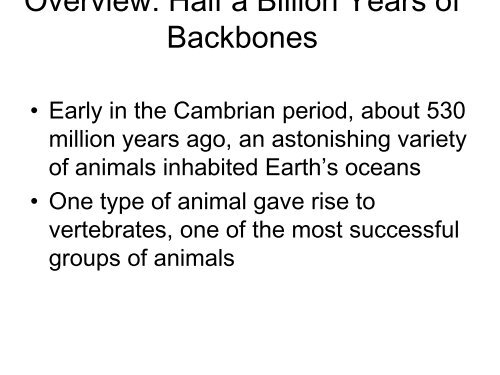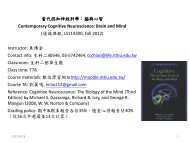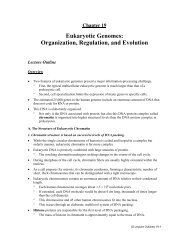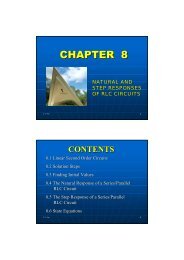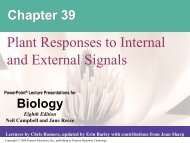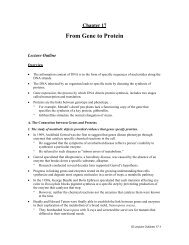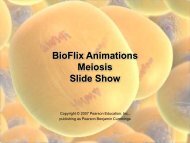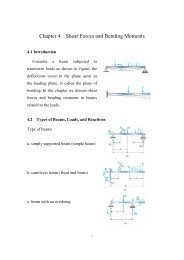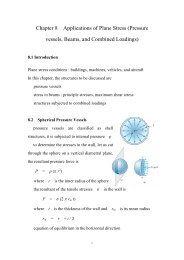vertebrates
vertebrates
vertebrates
Create successful ePaper yourself
Turn your PDF publications into a flip-book with our unique Google optimized e-Paper software.
Overview: Half a Billion Years of<br />
Backbones<br />
• Early in the Cambrian period, about 530<br />
million years ago, an astonishing variety<br />
of animals inhabited Earth’s oceans<br />
• One type of animal gave rise to<br />
<strong>vertebrates</strong>, one of the most successful<br />
groups of animals
• The animals called <strong>vertebrates</strong> get their<br />
name from vertebrae, the series of bones<br />
that make up the backbone<br />
• There are about 52,000 species of<br />
<strong>vertebrates</strong>, including the largest<br />
organisms ever to live on the Earth<br />
• Vertebrates have great disparity, a wide<br />
range of differences within the group
Concept 34.1: Chordates have a<br />
notochord and a dorsal, hollow<br />
nerve cord<br />
• Vertebrates are a subphylum within the<br />
phylum Chordata<br />
• Chordates are bilaterian animals that<br />
belong to the clade of animals known as<br />
Deuterostomia<br />
• Two groups of invertebrate<br />
deuterostomes, the urochordates and<br />
cephalochordates, are more closely<br />
related to <strong>vertebrates</strong> than to other<br />
in<strong>vertebrates</strong>
Fig. 34-2<br />
ANCESTRAL<br />
DEUTERO-<br />
STOME<br />
Notochord<br />
Common<br />
ancestor of<br />
chordates<br />
Head<br />
Vertebral column<br />
Jaws, mineralized skeleton<br />
Lungs or lung derivatives<br />
Lobed fins<br />
Echinodermata<br />
(sister group to chordates)<br />
Cephalochordata<br />
(lancelets)<br />
Urochordata<br />
(tunicates)<br />
Myxini<br />
(hagfishes)<br />
Petromyzontida<br />
(lampreys)<br />
Chondrichthyes<br />
(sharks, rays, chimaeras)<br />
Actinopterygii<br />
(ray-finned fishes)<br />
Actinistia<br />
(coelacanths)<br />
Dipnoi<br />
(lungfishes)<br />
Amphibia (frogs,<br />
salamanders)<br />
Legs<br />
Amniotic egg<br />
Milk<br />
Reptilia<br />
(turtles, snakes,<br />
crocodiles, birds)<br />
Mammalia<br />
(mammals)
Fig. 34-3<br />
Muscle<br />
segments<br />
Notochord<br />
Dorsal,<br />
hollow<br />
nerve cord<br />
Mouth<br />
Muscular,<br />
post-anal tail<br />
Anus<br />
Pharyngeal<br />
slits or clefts
Notochord<br />
• The notochord is a longitudinal, flexible<br />
rod between the digestive tube and nerve<br />
cord<br />
• It provides skeletal support throughout<br />
most of the length of a chordate<br />
• In most <strong>vertebrates</strong>, a more complex,<br />
jointed skeleton develops, and the adult<br />
retains only remnants of the embryonic<br />
notochord
Fig. 34-4<br />
Cirri<br />
2 cm<br />
Mouth<br />
Pharyngeal slits<br />
Atrium<br />
Notochord<br />
Dorsal, hollow<br />
nerve cord<br />
Digestive tract<br />
Atriopore<br />
Segmental<br />
muscles<br />
Anus<br />
Tail
Fig. 34-5<br />
An adult tunicate<br />
Incurrent<br />
siphon<br />
to mouth<br />
Excurrent<br />
siphon<br />
Atrium<br />
Pharynx<br />
with<br />
slits<br />
Tunic<br />
Water flow<br />
Excurrent<br />
siphon<br />
Anus<br />
Intestine<br />
Esophagus<br />
Stomach<br />
Dorsal, hollow<br />
nerve cord<br />
Incurrent<br />
siphon<br />
Excurrent<br />
siphon<br />
Notochord<br />
Atrium<br />
Pharynx with slits<br />
A tunicate larva<br />
Tail<br />
Muscle<br />
segments<br />
Intestine<br />
Stomach
Early Chordate Evolution<br />
• Ancestral chordates may have resembled<br />
lancelets<br />
• Genome sequencing of tunicates has<br />
identified genes shared by tunicates and<br />
<strong>vertebrates</strong><br />
• Gene expression in lancelets holds clues<br />
to the evolution of the vertebrate form
Fig. 34-6<br />
BF1<br />
Otx<br />
Hox3<br />
Nerve cord of lancelet<br />
embryo<br />
BF1<br />
Otx<br />
Hox3<br />
Brain of vertebrate embryo<br />
(shown straightened)<br />
Forebrain<br />
Midbrain<br />
Hindbrain
Concept 34.2: Craniates are<br />
chordates that have a head<br />
• The origin of a head opened up a<br />
completely new way of feeding for<br />
chordates: active predation<br />
• Craniates share some characteristics:<br />
a skull, brain, eyes, and other sensory<br />
organs
Derived Characters of Craniates<br />
• Craniates have two clusters of Hox genes;<br />
lancelets and tunicates have only one<br />
cluster<br />
• One feature unique to craniates is the<br />
neural crest, a collection of cells near<br />
the dorsal margins of the closing neural<br />
tube in an embryo<br />
• Neural crest cells give rise to a variety of<br />
structures, including some of the bones<br />
and cartilage of the skull
Fig. 34-7<br />
Dorsal edges<br />
of neural plate<br />
Neural<br />
crest<br />
Neural<br />
tube<br />
Notochord<br />
Migrating neural<br />
crest cells
• In aquatic craniates the pharyngeal clefts<br />
evolved into gill slits<br />
• Craniates have a higher metabolism and<br />
are more muscular than tunicates and<br />
lancelets<br />
• Craniates have a heart with at least two<br />
chambers, red blood cells with<br />
hemoglobin, and kidneys
The Origin of Craniates<br />
• Fossils from the Cambrian explosion 530<br />
million years ago document the transition<br />
to craniates<br />
• The most primitive of the fossils are those<br />
of the 3-cm-long Haikouella<br />
• Haikouella had a well-formed brain, eyes,<br />
and muscular segments, but not a skull
• In other Cambrian rocks,<br />
paleontologists have found fossils of<br />
even more advanced chordates, such<br />
as Myllokunmingia<br />
• Myllokunmingia had a skull and was a<br />
true craniate
Hagfishes<br />
• The least derived surviving craniate<br />
lineage is Myxini, the hagfishes<br />
• Hagfishes have a cartilaginous skull and<br />
axial rod of cartilage derived from the<br />
notochord, but lack jaws and vertebrae
Fig. 34-UN3<br />
Cephalochordata<br />
Urochordata<br />
Myxini<br />
Petromyzontida<br />
Chondrichthyes<br />
Actinopterygii<br />
Actinistia<br />
Dipnoi<br />
Amphibia<br />
Reptilia<br />
Mammalia
Fig. 34-9<br />
Slime glands
Concept 34.3: Vertebrates are<br />
craniates that have a backbone<br />
• During the Cambrian period, a lineage<br />
of craniates evolved into <strong>vertebrates</strong><br />
• Vertebrates became more efficient at<br />
capturing food and avoiding being eaten
Derived Characters of<br />
Vertebrates<br />
• Vertebrates underwent a second gene<br />
duplication involving the Dlx family of<br />
transcription factors<br />
• Vertebrates have the following derived<br />
characters:<br />
– Vertebrae enclosing a spinal cord<br />
– An elaborate skull<br />
– Fin rays, in the aquatic forms
Lampreys<br />
• Lampreys (Petromyzontida) represent the<br />
oldest living lineage of <strong>vertebrates</strong><br />
• They are jawless <strong>vertebrates</strong> inhabiting<br />
various marine and freshwater habitats<br />
• They have cartilaginous segments<br />
surrounding the notochord and arching<br />
partly over the nerve cord
Fig. 34-UN4<br />
Cephalochordata<br />
Urochordata<br />
Myxini<br />
Petromyzontida<br />
Chondrichthyes<br />
Actinopterygii<br />
Actinistia<br />
Dipnoi<br />
Amphibia<br />
Reptilia<br />
Mammalia
Fig. 34-10
Fossils of Early Vertebrates<br />
• Conodonts were the first <strong>vertebrates</strong><br />
with mineralized skeletal elements in<br />
their mouth and pharynx
Fig. 34-11<br />
Dental elements
• Other armored, jawless <strong>vertebrates</strong> had<br />
defensive plates of bone on their skin
Fig. 34-12<br />
Pteraspis<br />
Pharyngolepis
Origins of Bone and Teeth<br />
• Mineralization appears to have<br />
originated with vertebrate mouthparts<br />
• The vertebrate endoskeleton became<br />
fully mineralized much later
Concept 34.4: Gnathostomes are<br />
<strong>vertebrates</strong> that have jaws<br />
• Today, jawed <strong>vertebrates</strong>, or<br />
gnathostomes, outnumber jawless<br />
<strong>vertebrates</strong>
Fig. 34-13-3<br />
Gill slits<br />
Cranium<br />
Mouth<br />
Skeletal rods
• Other characters common to<br />
gnathostomes:<br />
– An additional duplication of Hox genes<br />
– An enlarged forebrain associated with<br />
enhanced smell and vision<br />
– In aquatic gnathostomes, the lateral line<br />
system, which is sensitive to vibrations
Fossil Gnathostomes<br />
• The earliest gnathostomes in the fossil<br />
record are an extinct lineage of armored<br />
<strong>vertebrates</strong> called placoderms
Fig. 34-14<br />
0.5 m
• Another group of jawed <strong>vertebrates</strong><br />
called acanthodians radiated during the<br />
Devonian period
Chondrichthyans (Sharks, Rays,<br />
and Their Relatives)<br />
• Chondrichthyans (Chondrichthyes)<br />
have a skeleton composed primarily of<br />
cartilage<br />
• The cartilaginous skeleton evolved<br />
secondarily from an ancestral mineralized<br />
skeleton<br />
• The largest and most diverse group of<br />
chondrichthyans includes the sharks,<br />
Video: Shark Eating Seal<br />
rays, and skates<br />
Video: Manta Ray
Fig. 34-UN5<br />
Cephalochordata<br />
Urochordata<br />
Myxini<br />
Petromyzontida<br />
Chondrichthyes<br />
Actinopterygii<br />
Actinistia<br />
Dipnoi<br />
Amphibia<br />
Reptilia<br />
Mammalia
Fig. 34-15a<br />
Pectoral fins<br />
Pelvic fins<br />
(a) Blacktip reef shark (Carcharhinus melanopterus)
Fig. 34-15b<br />
(b) Southern stingray (Dasyatis americana)
• Most sharks<br />
– Have a streamlined body and are swift<br />
swimmers<br />
– Are carnivores<br />
– Have a short digestive tract; a ridge called the<br />
spiral valve increases the digestive surface area<br />
– Have acute senses
• Shark eggs are fertilized internally but<br />
embryos can develop in different ways:<br />
– Oviparous: eggs hatch outside the mother’s<br />
body<br />
– Ovoviviparous: the embryo develops within the<br />
uterus and is nourished by the egg yolk<br />
– Viviparous: the embryo develops within the<br />
uterus and is nourished through a yolk sac<br />
placenta from the mother’s blood
Ray-Finned Fishes<br />
• Class Actinopterygii, the ray-finned<br />
fishes, includes nearly all the familiar<br />
aquatic osteichthyans<br />
• The fins, supported mainly by long,<br />
flexible rays, are modified for<br />
maneuvering, defense, and other<br />
functions<br />
Video: Clownfish and Anemone<br />
Video: Coral Reef<br />
Video: Seahorse Camouflage
Fig. 34-16<br />
Brain<br />
Spinal cord<br />
Swim<br />
bladder<br />
Dorsal fin<br />
Adipose fin<br />
(characteristic<br />
of trout)<br />
Caudal<br />
fin<br />
Nostril<br />
Cut edge<br />
of operculum<br />
Gills<br />
Kidney<br />
Heart<br />
Liver<br />
Stomach<br />
Intestine<br />
Gonad<br />
Pelvic<br />
fin<br />
Anus<br />
Urinary<br />
bladder<br />
Lateral<br />
line<br />
Anal fin
Fig. 34-17a<br />
(a) Yellowfin tuna (Thunnus albacares)
Fig. 34-17b<br />
(b) Clownfish (Amphiprion ocellaris)
Fig. 34-17c<br />
(c) Sea horse (Hippocampus<br />
ramulosus)
Fig. 34-17d<br />
(d) Fine-spotted moray eel<br />
(Gymnothorax dovii)
Lobe-Fins<br />
• The lobe-fins (Sarcopterygii) have<br />
muscular pelvic and pectoral fins<br />
• Three lineages survive and include<br />
coelacanths, lungfishes, and tetrapods
Fig. 34-18
Concept 34.5: Tetrapods are<br />
gnathostomes that have limbs<br />
• One of the most significant events in<br />
vertebrate history was when the fins of<br />
some lobe-fins evolved into the limbs<br />
and feet of tetrapods
Derived Characters of Tetrapods<br />
• Tetrapods have some specific<br />
adaptations:<br />
– Four limbs, and feet with digits<br />
– Ears for detecting airborne sounds
The Origin of Tetrapods<br />
• In one lineage of lobe-fins, the fins<br />
became progressively more limb-like<br />
while the rest of the body retained<br />
adaptations for aquatic life<br />
• For example, Acanthostega lived in<br />
Greenland 365 million years ago
Fig. 34-19<br />
Bones<br />
supporting<br />
gills<br />
Tetrapod<br />
limb<br />
skeleton
Fig. 34-20<br />
Ray-finned fishes<br />
Coelacanths<br />
Lungfishes<br />
Eusthenopteron<br />
Panderichthys<br />
Tiktaalik<br />
Elginerpeton<br />
Metaxygnathus<br />
Acanthostega<br />
Ichthyostega<br />
Hynerpeton<br />
Greerpeton<br />
Amphibians<br />
Amniotes<br />
PALEOZOIC<br />
Silurian Devonian Carboniferous<br />
Permian<br />
430<br />
415<br />
400<br />
385<br />
370<br />
355<br />
340<br />
325<br />
310<br />
295<br />
280<br />
265<br />
0<br />
Time (millions of years ago)
Amphibians<br />
• Amphibians (class Amphibia) are<br />
represented by about 6,150 species of<br />
organisms in three orders<br />
• Order Urodela includes salamanders,<br />
which have tails
Fig. 34-21a<br />
(a) Order Urodela
Fig. 34-21b<br />
(b) Order Anura
Fig. 34-21c<br />
(c) Order Apoda
• Amphibian means “both ways of life,”<br />
referring to the metamorphosis of an<br />
aquatic larva into a terrestrial adult<br />
• Most amphibians have moist skin that<br />
complements the lungs in gas exchange<br />
• Fertilization is external in most species,<br />
and the eggs require a moist environment
Fig. 34-23
Derived Characters of Amniotes<br />
• Amniotes are named for the major<br />
derived character of the clade, the<br />
amniotic egg, which contains<br />
membranes that protect the embryo<br />
• The extraembryonic membranes are the<br />
amnion, chorion, yolk sac, and allantois
Fig. 34-25<br />
Amnion<br />
Allantois<br />
Chorion<br />
Yolk sac<br />
Embryo<br />
Amniotic<br />
cavity<br />
with<br />
amniotic<br />
fluid<br />
Yolk<br />
(nutrients)<br />
Shell<br />
Albumen
Early Amniotes<br />
• Living amphibians and amniotes split<br />
from a common ancestor about 370<br />
million years ago<br />
• Early amniotes were more tolerant of<br />
dry conditions than early tetrapods
Reptiles<br />
• The reptile clade includes the tuataras,<br />
lizards, snakes, turtles, crocodilians, birds,<br />
and the extinct dinosaurs<br />
• Reptiles have scales that create a<br />
waterproof barrier<br />
• They lay shelled eggs on land
Fig. 34-26
• Most reptiles are ectothermic,<br />
absorbing external heat as the main<br />
source of body heat<br />
• Birds are endothermic, capable of<br />
keeping the body warm through<br />
metabolism
The Origin and Evolutionary<br />
Radiation of Reptiles<br />
• The oldest reptilian fossils date to about<br />
310 million years ago<br />
• The first major group to emerge were<br />
parareptiles, which were mostly large,<br />
stocky herbivores
千 禧 中 國 鳥 龍
Derived Characters of Birds<br />
• Many characters of birds are adaptations<br />
that facilitate flight<br />
• The major adaptation is wings with<br />
keratin feathers<br />
• Other adaptations include lack of a<br />
urinary bladder, females with only one<br />
ovary, small gonads, and loss of teeth
Fig. 34-28<br />
(a) Wing<br />
Shaft<br />
Vane<br />
Forearm<br />
Wrist<br />
Finger 1<br />
Shaft<br />
Barb<br />
Barbule<br />
Hook<br />
(b) Bone structure<br />
Palm<br />
Finger 2<br />
Finger 3<br />
(c) Feather structure
The Origin of Birds<br />
• Birds probably descended from small<br />
theropods, a group of carnivorous<br />
dinosaurs<br />
• By 150 million years ago, feathered<br />
theropods had evolved into birds<br />
• Archaeopteryx remains the oldest bird<br />
known
Fig. 34-29<br />
Toothed beak<br />
Wing claw<br />
Airfoil wing<br />
with contour<br />
feathers<br />
Long tail with<br />
many vertebrae
Concept 34.7: Mammals are<br />
amniotes that have hair and<br />
produce milk<br />
• Mammals, class Mammalia, are<br />
represented by more than 5,300<br />
species
Derived Characters of Mammals<br />
• Mammals have<br />
– Mammary glands, which produce milk<br />
– Hair<br />
– A larger brain than other <strong>vertebrates</strong> of<br />
equivalent size<br />
– Differentiated teeth
Fig. 34-31<br />
Temporal<br />
fenestra<br />
Jaw joint<br />
Key<br />
Articular<br />
Quadrate<br />
Dentary<br />
Squamosal<br />
(a) In Biarmosuchus, an early synapsid, the articular and<br />
quadrate bones formed the jaw joint.<br />
Middle ear<br />
Eardrum Stapes<br />
Inner ear<br />
Eardrum<br />
Middle ear<br />
Inner ear<br />
Stapes<br />
Sound<br />
Sound<br />
Incus (quadrate)<br />
Malleus (articular)<br />
Present-day reptile<br />
Present-day mammal<br />
(b) In mammals, the articular and quadrate bones are incorporated into the middle ear.
• By the early Cretaceous, the three living<br />
lineages of mammals emerged:<br />
monotremes, marsupials, and<br />
eutherians<br />
• Mammals did not undergo a significant<br />
adaptive radiation until after the<br />
Cretaceous
Fig. 34-32
Marsupials<br />
• Marsupials include opossums,<br />
kangaroos, and koalas<br />
• The embryo develops within a placenta<br />
in the mother’s uterus<br />
• A marsupial is born very early in its<br />
development<br />
• It completes its embryonic development<br />
while nursing in a maternal pouch called<br />
a marsupium
Fig. 34-33a<br />
(a) A young brushtail possum
Fig. 34-34<br />
Marsupial<br />
mammals<br />
Eutherian<br />
mammals<br />
Marsupial<br />
mammals<br />
Eutherian<br />
mammals<br />
Plantigale<br />
Deer mouse<br />
Wombat<br />
Woodchuck<br />
Marsupial mole<br />
Mole<br />
Tasmanian devil<br />
Wolverine<br />
Sugar glider<br />
Flying squirrel<br />
Kangaroo<br />
Patagonian cavy
Eutherians (Placental Mammals)<br />
• Compared with marsupials, eutherians<br />
have a longer period of pregnancy<br />
• Young eutherians complete their<br />
embryonic development within a uterus,<br />
joined to the mother by the placenta<br />
• Molecular and morphological data give<br />
conflicting dates on the diversification of<br />
eutherians
Fig. 34-35b
Fig. 34-37<br />
ANCESTRAL<br />
PRIMATE<br />
Lemurs, lorises,<br />
and pottos<br />
Tarsiers<br />
New World monkeys<br />
Old World monkeys<br />
Gibbons<br />
Orangutans<br />
Gorillas<br />
Chimpanzees<br />
and bonobos<br />
Humans<br />
60<br />
50<br />
40<br />
30<br />
20<br />
10<br />
0<br />
Time (millions of years ago)
Fig. 34-36
• The first monkeys evolved in the Old<br />
World (Africa and Asia)<br />
• In the New World (South America),<br />
monkeys first appeared roughly 25 million<br />
years ago<br />
• New World and Old World monkeys<br />
underwent separate adaptive radiations<br />
during their many millions of years of<br />
separation
Fig. 34-38<br />
(a) New World monkey<br />
(b) Old World monkey


